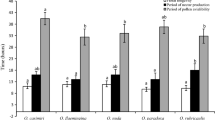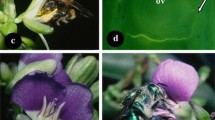Abstract
The primary pollinator of Polynesian heliconias,Heliconia laufao andH. paka, is the Wattled Honeyeater,Foulehaio carunculata. This report is the first documentation of pollination by honeyeaters in the genusHeliconia and the first record ofF. carunculata as a pollinator of a plant species. The Polynesian heliconias bear inflorescences that produce 2–4 hermaphroditic flowers per day for a period of 2–3 months. Each flower secretes abundant nectar (125–184 εl) with low sugar concentration (15–18% sucrose-equivalents, weight per weight basis) which is available at anthesis just before dawn. Ninety percent of flower visits occur between anthesis and mid-morning. The honeyeaters perch on inflorescence bracts, and probing of the flower results in pollen deposition on the head and bill from where pollen is transferred between flowers. No statements on compatibility can be made forHeliconia paka; however,Heliconia laufao appears to be self-compatible. Calculations of energetic values of nectar of the Polynesian heliconias and Daily Energy Expenditures ofF. carunculata suggest that populations ofH. laufao andH. paka serve as rich energy resources for their pollinators.
Similar content being viewed by others
References
Armstrong, D. P., 1992: Correlation between nectar supply and aggression in territorial honeyeaters: causation or coincidence? — Behav. Ecol. Sociobiol.30: 95–102.
Bolten, A. B., Feinsinger, P., Baker, H. G., Baker, I., 1979: On the calculation of sugar concentration in flower nectar. — Oecologia41: 301–304.
Brown, E. D., Hopkins, M. J. G., 1995: A test of pollinator specificity and morphological convergence between nectarivorous birds and rainforest tree flowers in New Guinea. — Oecologia103: 89–100.
Cox, P. A., 1983: Observations on the natural history of Samoan bats. — Mammalia47: 519–523.
—, 1984: Chiropterophily and ornithophily inFreycinetia (Pandanaceae) in Samoa. — Pl. Syst. Evol.144: 277–290.
Craig, J. L., Stewart, A. M., 1988: Reproductive biology ofPhormium tenax: a honeyeater-pollinated species — New Zealand J. Bot.26: 453–463.
Delph, L. F., Lively, C. M., 1989: The evolution of floral color change: pollinator attraction versus physiological constraints inFuchsia excorticata. — Evolution43: 1252–1262.
Endress, P. K., 1994: Diversity and evolutionary biology of tropical flowers. — Cambridge: Cambridge University Press.
Faegri, K., van der Pijl, L., 1979: The principles of pollination ecology. 3rd edn. — Oxford: Pergamon Press.
Ford, H. A., 1976: The honeyeaters of Kangaroo Island. — S. Austral. Orn.27: 134–138.
—, 1979: Birds as pollinators of Australian plants. — New Zealand Bot.17: 509–519.
Heinrich, B., 1975: Energetics of pollination. — Annual Rev. Ecol. Syst.6: 139–170.
Hopper, S. D., Burbidge, A. H., 1978: Assortative pollination by Red Wattebirds in a hybrid population ofAnigozanthus Labill (Haemodoraceae). — Austral. J. Bot.26: 335–350.
—, 1986: Speciation and bird-pollinated plants in south-western Australia. — InFord, H. A., Paton, D. C., (Eds): The dynamic partnership: birds and plants in Southern Australia, pp. 20–31. Adelaide: SA Government Printer.
Ippolito, A., Armstrong, J. E., 1993: Floral biology ofHornstedtia scottiana (Zingiberaceae) in a lowland rain forest of Australia. — Biotropica25: 281–289.
Kearns, C. A., Inouye, D. W., 1993: Techniques for pollination biologists. — Colorado: University Press of Colorado.
Keast, A., 1985: An introductory ecological biogeography of the Australo-PacificMeliphagidae. — New Zealand J. Zool.12: 605–622.
Keighery, G. J., 1982: Bird pollinated plants in Western Australia. — InArmstrong, J. A., Powell, J. H., Richards, A. J., (Eds): Pollination and evolution, pp. 77–89. — Sydney: Royal Botanic Garden.
Kress, W. J., 1983: Self-incompatibility systems in Central AmericanHeliconia. — Evolution37: 735–744.
—, 1985: Bat pollination of an Old WorldHeliconia. — Biotropica17: 302–308.
—, 1990: Taxonomy of Old WorldHeliconia (Heliconiaceae). — Allertonia6: 1–58.
—, 1995: Phylogeny of theZingiberanae: morphology and molecules. — InRudall, P., Cribb, P. J., Cutler, D. F., Humphries, C. J., (Eds): Monocotyledons: systematics and evolution, pp. 443–460. — Richmond: Royal Botanic Gardens, Kew.
-Beach, J. H., 1994: Flowering plant reproductive systems at La Selva Biological Station. — InMcDade, L. A., Bawa, K. S., Hespenheide, H., Hartshorn, G., (Eds): La Selva: ecology and natural history of a neotropical rain forest, pp. 161–182. — University of Chicago Press.
Schatz, G.E., Andrianifahanana, M., Morland, H. S., 1994: Pollination ofRavenala madagascariensis (Streliziaceae) by lemurs: evidence for an archaic coevolutionary system? — Amer. J. Bot.81: 542–551.
Kunz, T. H., 1980: Daily energy budget of free-living bats. — InWilson, D. E., Gardner, A. L., (Eds): Proceedings of the 5th International Bat Research Conference, pp. 369–392. — Lubbock: Texas Technical University Press.
Linhart, Y. B., 1973: Ecological and behavioral determinants of pollen dispersal in hummingbird pollinatedHeliconia. — Amer. Naturalist107: 511–523.
Martin, F. W., 1959: Staining and observing pollen tubes in the style by means of fluorescence. — Stain Technol.34: 125–128.
Paton, D. C., 1986: Evolution of bird pollination in Australia. — InFord, H. A., Paton, D. C., (Eds): The dynamic partnership: Birds and plants in Southern Australia, pp. 32–41. — Adelaide: SA Government Printer.
—, 1989: Bills and tongues of nectar-feeding birds: a review of morphology, function and performance, with intercontinental comparisons. — Austral. J. Ecol.14: 473–506.
Proctor, M., Yeo, P., Lack, A., 1996: The natural history of pollination. — Portland: Timber Press.
Pyke, G. H., 1980: The foraging behaviour of Australian honeyeaters: a review and some comparisons with hummingbirds. — Austral. J. Ecol.5: 343–369.
Stiles, F. G., 1975: Ecology, flowering phenology and hummingbird pollination of some Costa RicanHeliconia species. — Ecology56: 285–301.
—, 1978: Ecological and evolutionary implications of bird pollination. — Amer. Zool.18: 715–727.
—, 1979: Notes on the natural history ofHeliconia (Musaceae) in Costa Rica. — Brenesia15: (Suppl.) 151–180.
Walsberg, G. E., 1980: Energy expenditure in free-living birds: patterns and diversity. — Acta XVII Congr. Int. Ornithol., pp. 300–305. — Berlin.
Weast, R. C., Astle, M. J., Beyer, W. H., 1984–1985: CRC handbook of chemistry and physics. 65th edn. — Boca Raton, Florida: CRC Press.
Author information
Authors and Affiliations
Rights and permissions
About this article
Cite this article
Pedersen, L.B., Kress, W.J. Honeyeater (Meliphagidae) pollination and the floral biology of PolynesianHeliconia (Heliconiaceae). Pl Syst Evol 216, 1–21 (1999). https://doi.org/10.1007/BF00985098
Received:
Revised:
Accepted:
Issue Date:
DOI: https://doi.org/10.1007/BF00985098




